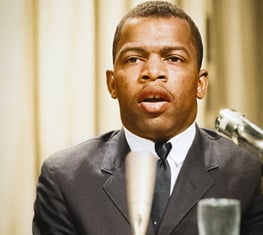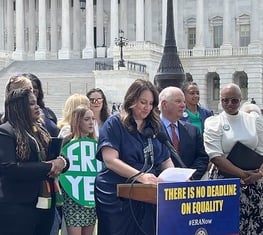The 2016 Presidential Election WAS Rigged
Voter Suppression Can Impact Outcomes
Washington, DC – This year, and for several years, there has been a concerted effort in many states to stop some voters from voting, or to make it much harder for them to participate. Since the Supreme Court rolled back key provisions of the Voting Rights Act in 2013, elected officials have purged existing voters from the rolls, made cuts to early voting, reduced polling places, put in place strict voter photo ID laws and levied onerous voter registration restrictions.
“We recognize the importance of a peaceful transfer of power as a hallmark of a functioning democracy, and we recognize that we have one of the best election systems and democracies in the world, but we also need to say it out loud: This election was rigged. And it needs to stop,” said Chris Carson, president of the League of Women Voters of the United States.
“It is clear that this kind of voter suppression could impact the outcome of elections,” Carson continued. “We may never know whether the efforts to block voter participation changed the outcome in any particular race – but we must be on guard for the future.”
Tight margins in some key elections show that suppression may play a role.
In Wisconsin, President-elect Trump beat Secretary Clinton by roughly 27,000 votes, however according to federal court, 300,000 registered voters lacked the proper photo ID. In North Carolina, the closest governor’s race the country has seen in more than a decade is still unresolved, with fewer than 8,000 votes separating the current governor from his challenger.
“We are not talking about vigilante voter intimidation,” said Carson. “We are talking about official, legal voter suppression by state legislatures and election officials.”
Carson pointed especially to the work of Kris Kobach, the Secretary of State of Kansas, who engaged in a multi-year effort to stop eligible Kansans from voting. Laws drafted by Kobach required restrictive documentary proof of citizenship to register by mail and at the DMV. Despite defeats in federal and state courts, Kobach still pushed to keep eligible citizens from voting.
“Some try to justify voter suppression as just politics as usual – trying to ensure their candidates will win,” Carson said. “There is no excuse for erecting unnecessary barriers to voting. It is not the American way.”
In 2016, the League worked to make sure voters impacted by new laws were aware of these restrictions. In Ohio, the League made thousands of phone calls to inform voters about that state’s purge. In Virginia, the League conducted outreach so voters knew about the new ID law. In Kansas, the League worked to register voters and provide them information. Across the country League members volunteered as non-partisan poll observers.
“Every eligible citizen should vote and the election system should help them participate rather than standing in the way,” said Carson. “The League of Women Voters will continue our work to expand participation in the election process and work to give a voice to all Americans,” she concluded.
The League is gearing up to take a stand in statehouses and courtrooms nationwide to ensure no voters are left behind.
What states rigged their elections? Here’s the list of 13 states with new voting restrictions in effect in the 2016 election:
1. Alabama saw a new restrictive photo ID requirement in 2016. There is ongoing litigation that could require voters to provide more burdensome documentary proof of citizenship when registering to vote.
2. Arizona for the first time had limitations on mail-in ballot collection. This law made it a felony to turn in another voter’s completed ballot. This practice is popular for rural and Native American communities that do not have access to reliable transportation or postal offices.
3. Indiana now permits election officers to demand voters provide proof of identification. This law subjects voters to an additional and duplicative voter identification requirement that did not exist before the law was enacted.
4. Kansas continued attempts to require documentary proof of citizenship in order to register to vote by mail and at the DMV. Courts overturned these requirements but many voters who tried to register were put on a suspense list.
5. Mississippi passed a restrictive photo ID requirement that was allowed to go into effect after the U.S Supreme Court gutted Section 5 of the Voting Rights Act in 2013.
6. New Hampshire enacted a new photo ID law, requiring voters without acceptable ID to be photographed at the polls, and the photograph to be affixed to an affidavit.
7. Ohio made cuts to early voting and changed absentee and provisional ballot rules. The Buckeye State also eliminated the period known as “Golden Week”, when voters can register and cast a ballot on the same day. The Secretary of State also purged more than 1 million Ohio voters from the registration rolls.
8. Rhode Island voters needed to provide a valid photo ID to vote this year. Voters without ID could only cast provisional ballots.
9. South Carolina for the first time required voters who have photo IDs to produce them in order to vote in this presidential election. Voters without ID needed to sign an affidavit at the polls and could only cast a provisional ballot.
10. Tennessee lawmakers made the photo ID law already in place more restrictive by limiting acceptable IDs to only those issued by the state or federal government. The state conducted an illegal purge of voters who hadn’t recently voted.
11. Texas instituted one of the most restrictive photo ID laws in the nation, but was blocked in the courts. The state then required voters with ID to produce it, and individuals lacking the official ID could vote only after showing a different form of identification and signing a declaration.
12. Virginia limited voter registration by civic organizations and required restrictive photo ID for the first time.
13. Wisconsin reduced early voting hours on weekdays and eliminated them entirely on weekends. Voters also were required to show photo IDs for the first time.
###
Contact: Sarah Courtney
(202) 263-1332 (office)
Sign Up For Email
Keep up with the League. Receive emails to your inbox!
Donate to support our work
to empower voters and defend democracy.





